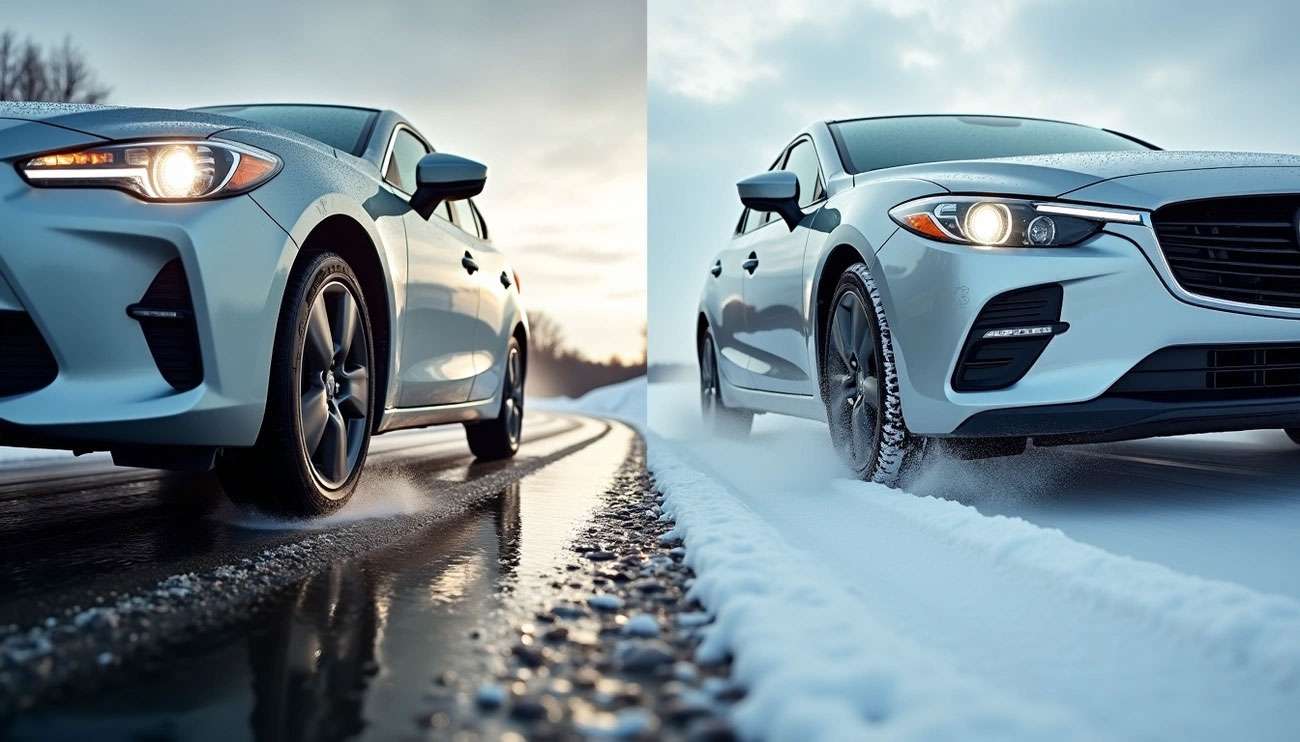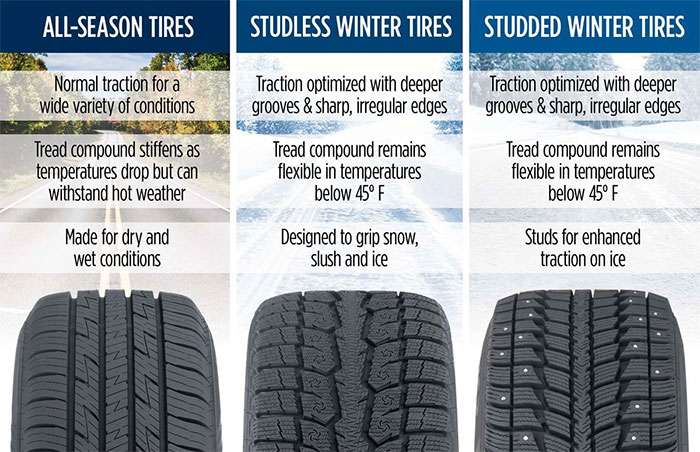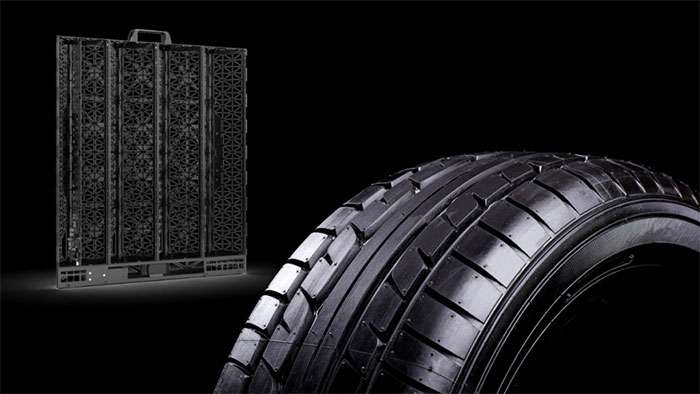
The Goodyear Assurance WeatherReady 2 vs Michelin CrossClimate 2 represents one of the most important tire decisions facing drivers today. These two premium all-weather champions deliver exceptional performance across different weather conditions, each with distinct advantages that set them apart from the competition.
Michelin's CrossClimate 2 has established itself as the benchmark in all-weather performance, offering unmatched versatility for drivers who demand reliability. Goodyear launched the Assurance WeatherReady 2 as a direct challenger, engineered specifically to compete with Michelin's market-leading design.
Both tires proudly display the Three Peak Mountain Snowflake rating, certifying their ability to handle severe winter conditions. The performance numbers tell the story: Goodyear's WeatherReady 2 delivers superior wet braking performance, stopping 5.1 feet shorter than the Michelin. However, the CrossClimate 2 fights back with better winter capabilities, stopping 0.95 feet shorter in snow and an impressive 2.5 feet shorter on ice. The fuel efficiency battle heavily favors Michelin, with 24% lower rolling resistance delivering significant savings at the pump.
We've tested both tires extensively to help you determine which option provides the best value for your specific driving conditions. Our detailed analysis covers everything from stopping power and handling characteristics to long-term durability and pricing, giving you the expert guidance needed to make the right choice for your vehicle.
Real-world performance testing reveals where each tire truly shines. These results matter most when you need maximum stopping power or precise control during critical driving moments.
The Michelin CrossClimate 2 delivers superior dry braking performance, stopping 7.1 feet shorter than the Goodyear Assurance WeatherReady 2 on dry pavement. This 5% advantage in stopping power translates to meaningful safety benefits during emergency situations on dry roads. Michelin achieves this through specialized tread compounds engineered to maximize grip during hard braking.
Here's where Goodyear fights back. The Assurance WeatherReady 2 completes dry handling courses 0.73 seconds faster than its Michelin rival, representing a 1% advantage in overall agility. Subjective testing scores favor Goodyear at 10 points compared to Michelin's 9.75. Drivers consistently report that the WeatherReady 2 provides more direct steering feedback and quicker responses, delivering what testers describe as a more "summer-like" driving experience.
Wet conditions reveal Goodyear's engineering focus. The Assurance WeatherReady 2 stops 5.1 feet shorter than the CrossClimate 2 on wet surfaces. This 5% improvement in wet braking provides crucial safety margins when roads turn slippery. Goodyear credits this performance to their AquaTred® Technology with Evolving Traction™ Grooves, which effectively channels water away from the tire's contact patch.
The wet handling advantage continues for Goodyear. The WeatherReady 2 navigates wet test courses 0.87 seconds faster than the CrossClimate 2, demonstrating superior control when roads become treacherous. Testers rate Goodyear higher at 10 points versus Michelin's 9.5. Independent testing ranks the WeatherReady 2 first in wet handling among comparable all-weather tires, making it the clear choice for drivers who regularly face rainy conditions.
Despite Goodyear's wet performance dominance, Michelin excels in one critical area. The CrossClimate 2 resists hydroplaning at speeds 2.6 mph higher than the WeatherReady 2. This 5% advantage stems from Michelin's distinctive V-shaped tread pattern, which efficiently evacuates standing water from beneath the tire.

Image Source: VS Code Containers: Blog Insights
Winter conditions separate capable all-weather tires from truly exceptional ones. The performance differences between these two contenders become most pronounced when roads turn slippery and dangerous.
When you need to stop on snow-covered roads, the Michelin CrossClimate 2 delivers superior snow stopping power, halting 0.95 feet shorter than the Goodyear Assurance WeatherReady 2. This 2% advantage might seem small, but those extra inches can mean the difference between stopping safely and sliding into trouble.
Snow handling tests reveal a clear winner. The CrossClimate 2 completes snow courses 2.36 seconds faster than the WeatherReady 2, representing a 3% advantage in snow agility. Driver confidence ratings support these numbers, with Michelin earning 9.5 points compared to Goodyear's 9.0. This translates to better control when navigating snowy intersections, hills, and curves.
Ice presents the ultimate challenge for any tire, and here the CrossClimate 2 shows its strongest advantage. Stopping 2.5 feet shorter than the WeatherReady 2 represents a substantial 7% improvement in icy braking capability. This performance gap becomes critical during unpredictable winter driving situations where every foot counts.
Getting moving on ice proves just as important as stopping. Michelin maintains its winter advantage with 0.63 seconds quicker acceleration on ice, delivering a 6% traction benefit. For drivers who regularly face harsh winter conditions, this consistent performance edge provides valuable peace of mind.
Both tires earn the Three-Peak Mountain Snowflake (3PMSF) symbol, certifying they exceed minimum requirements for severe snow service. This rating means you can confidently tackle winter roads without switching to dedicated winter tires.

Image Source: Sorama
Daily driving comfort matters just as much as performance numbers when you're spending hours behind the wheel. These all-weather contenders deliver notably different experiences in terms of ride quality and cabin refinement.
The Goodyear Assurance WeatherReady 2 delivers superior ride comfort with a 9.5-point rating compared to the Michelin CrossClimate 2's 8.5 points. This 1-point advantage represents a 5% improvement in overall comfort experience. Drivers consistently report that the WeatherReady 2 provides better shock absorption over rough pavement while maintaining excellent stability. The tire excels at smoothing out road imperfections without sacrificing handling precision.
Noise testing reveals the CrossClimate 2 operates at 72 dB versus the WeatherReady 2's 72.9 dB. While this 0.9 dB difference appears minimal, it gives the Michelin a slight edge in external noise levels during objective testing.
Both tires score identical 9-point ratings for subjective cabin noise, meaning you won't notice any meaningful difference in interior sound levels regardless of which tire you choose. This makes other factors more important in your decision-making process.
The CrossClimate 2 features Michelin's advanced polyurethane foam technology that reduces interior noise by approximately 20%. This specialized foam works with the tread pattern design to minimize road vibrations and create a more refined highway driving experience. The technology particularly benefits drivers who spend significant time on long-distance trips or highway commuting.
Ownership costs extend far beyond the initial purchase price, with fuel efficiency and tread life creating substantial differences over thousands of miles of driving.
The numbers tell a clear story: Michelin's CrossClimate 2 registers 7.05 N/kN compared to Goodyear's 9.24 N/kN, delivering 24% lower rolling resistance. This advantage translates directly into 4-8% better fuel economy for both gasoline and electric vehicles. Testing reveals the Goodyear had the highest rolling resistance among seven all-weather tires evaluated, making fuel costs an important consideration for high-mileage drivers.
Goodyear engineers designed the Assurance WeatherReady 2 with a stiffer, durability-focused compound specifically to extend tire life. The warranty expectations suggest the WeatherReady 2 should deliver up to 60% longer tread life compared to the Michelin option, potentially offsetting the higher fuel costs over time.
The Goodyear offers a unique advantage with its built-in Wear Gage, allowing you to monitor tread depth throughout the tire's lifespan. This exclusive feature helps you maximize tire life and plan replacement timing more effectively.
Price-conscious buyers will appreciate the Goodyear's advantage at approximately $213 versus Michelin's $220 for 225/65R17 size, making it 3% more affordable. Check current pricing at Performance Plus Tire or for Michelin options.
Goodyear backs the Assurance WeatherReady 2 with a 60,000-mile (95,000-kilometer) tread life limited warranty plus a 60-day satisfaction guarantee. This warranty coverage provides additional value and peace of mind for your investment.
Our testing results reveal clear performance differences between these two premium all-weather options. Here's how the Goodyear Assurance WeatherReady 2 and Michelin CrossClimate 2 stack up across all key categories:
Category |
Feature |
Goodyear Assurance WeatherReady 2 |
Michelin CrossClimate 2 |
Dry Performance | Dry Braking | +7.1 ft (longer) | Baseline |
Dry Handling Lap Time | 0.73s faster | Baseline | |
Subjective Dry Handling | 10 points | 9.75 points | |
Wet Performance | Wet Braking | 5.1 ft shorter | Baseline |
Wet Handling Lap Time | 0.87s faster | Baseline | |
Aquaplaning Resistance | -2.6 mph | Baseline | |
Winter Performance | Snow Braking | +0.95 ft (longer) | Baseline |
Snow Handling Lap Time | +2.36s (slower) | Baseline | |
Ice Braking | +2.5 ft (longer) | Baseline | |
Ice Traction | 0.63s slower | Baseline | |
3PMSF Certification | Yes | Yes | |
Comfort & Noise | Subjective Comfort Rating | 9.5 points | 8.5 points |
Exterior Noise Level | 72.9 dB | 72.0 dB | |
Cabin Noise Rating | 9 points | 9 points | |
Practical Aspects | Rolling Resistance | 9.24 N/kN | 7.05 N/kN |
Built-in Wear Gage | Yes | Not mentioned | |
Warranty | 60,000 miles | Not mentioned | |
Price (225/65R17) | $213 | $220 |
The choice between these two premium all-weather contenders comes down to your specific driving environment and priorities. Both tires deliver exceptional performance that eliminates the need for seasonal tire changes while maintaining safety across all conditions.
The Michelin CrossClimate 2 stands as the clear winner for drivers who face harsh winter conditions regularly. Its superior snow and ice performance makes it the safer choice when temperatures drop and roads become treacherous. The significant fuel economy advantage from lower rolling resistance also delivers real savings over the tire's lifetime, especially for high-mileage drivers.
Goodyear's Assurance WeatherReady 2 excels for drivers who encounter frequent rain and value long-term durability. Its superior wet-weather stopping power and handling provide crucial safety margins during sudden downpours. The enhanced comfort ratings and comprehensive 60,000-mile warranty make it an excellent value proposition for drivers seeking peace of mind.
Budget-conscious buyers will appreciate Goodyear's lower upfront cost, while the built-in wear gauge helps maximize tire life through proper maintenance monitoring. The WeatherReady 2 represents smart spending for drivers who prioritize immediate savings and extended tread life.
Your regional climate should guide your decision. Choose the Michelin CrossClimate 2 if you regularly navigate snow and ice conditions or drive many miles annually. Select the Goodyear Assurance WeatherReady 2 if you face more rain than snow or want maximum durability with upfront cost savings.
Both options represent smart investments that deliver reliable all-weather capability. We recommend checking current availability and pricing for the Goodyear Assurance WeatherReady and Michelin CrossClimate 2 to secure the best deal for your specific tire size.
When choosing between these premium all-weather tires, your decision should align with your specific driving conditions and priorities.
• Michelin CrossClimate 2 dominates winter performance - stops 2.5 feet shorter on ice and 0.95 feet shorter in snow, making it ideal for harsh winter climates
• Goodyear WeatherReady 2 excels in wet conditions - delivers 5.1 feet shorter wet braking distance and superior wet handling for rainy climates
• Fuel efficiency favors Michelin significantly - 24% lower rolling resistance translates to 4-8% better fuel economy over the tire's lifetime
• Goodyear offers better value and durability - costs $7 less per tire while providing 60,000-mile warranty and built-in wear gage for longevity tracking
• Both tires carry 3PMSF winter certification - eliminating need for seasonal tire changes while maintaining safety across all weather conditions
Choose Michelin if you face frequent snow and ice conditions or prioritize fuel savings. Select Goodyear if you encounter more rain than snow or value comfort, durability, and upfront cost savings.
The Michelin CrossClimate 2 demonstrates superior winter performance, with shorter braking distances on snow and ice, as well as better handling in snowy conditions compared to the Goodyear Assurance WeatherReady 2.
The Michelin CrossClimate 2 offers significantly better fuel efficiency with 24% lower rolling resistance compared to the Goodyear Assurance WeatherReady 2. This can translate to approximately 4-8% better fuel economy in both gas and electric vehicles.
The Goodyear Assurance WeatherReady 2 excels in wet conditions, offering shorter braking distances and better handling on wet roads compared to the Michelin CrossClimate 2. However, the Michelin has slightly better resistance to hydroplaning.
While the Goodyear Assurance WeatherReady 2 scores slightly higher in subjective comfort ratings, the Michelin CrossClimate 2 is marginally quieter in exterior noise tests. However, perceived cabin noise is similar for both tires.
The Goodyear Assurance WeatherReady 2 comes with a 60,000-mile tread life limited warranty and features a built-in wear gage. It also uses a stiffer compound that may contribute to longer tread life. Specific warranty information for the Michelin CrossClimate 2 was not provided in the comparison.